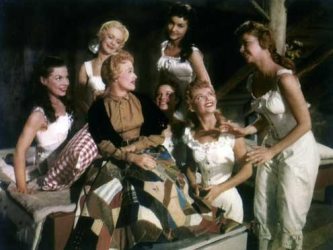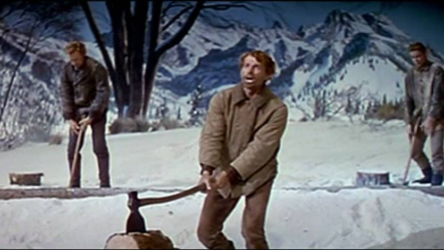In my most recent look at It’s A Wonderful Life, I referred to Gloria Grahame as “aggressively heterosexual”, a statement I stand by. That said, I hadn’t seen anything yet, because if that label applies to anything, it applies to a musical based on the Roman legend of the Rape of the Sabine—Seven Brides for Seven Brothers. We happened to catch a viewing with Russ Tamblyn talking beforehand—the second actor from West Side Story we’ve seen in person, and with the Flower having the same response of “I wish they would do the Q&A after so I knew if these guys were any good”—and he and the host spoke in cautious, nearly whispered tones about how the movie would not be possible in modern times.
Can we stop saying “modern” and start saying “repressive”? Because it feels more repressive than modern to me.

When I was a kid, six girls in their skivvies mean there was an axe murderer nearby.
Russ Tamblyn said the movie was premised on this peculiar circumstance: Gene Kelly, apparently, preferred to use gay men for his backup dancers so that he would be the focus of (female) attention during the dance numbers. So what if, Tamblyn mused, we made a movie where the dancers were all straight? Hold that thought; we’re going to revisit it.
This is the plucky story of a mountain man named Adam who comes into town looking for a wife. He is utterly confident that he will find one—he’s willing to trade his mule, after all!—and he stumbles across the small-but-feisty Jane Powell who is adorable and can cook, and seeing a chance to get out from under the grind of serving a bunch of ungrateful, demanding men, agrees to go along with him.
When she gets to Adam’s cabin, of course, she finds out that Adam has six brothers and they live like animals. But on seeing Jane Powell, they all decide they want wives, too, so she teaches them, Snow White-style, how to behave a little better and not eat like pigs, and about the sorts of things that women like in men. It’s the classic dynamic between the sexes, which is borne out by the fact that when the boys go to a barn-raising/dance they easily woo the women of their dreams away from their soft townie rivals.

The color coordination, while wholly anachronistic, helps you tell the brothers apart.
Now, nobody in 2019 has much to say about 19th century men in the wilds of Oregon, even if they are in a “town”, but compared to the Mountain Men, they are sissified. The movie does this very well, with the brothers being charming but not too smooth around the edges in a way that is beguiling to the nubile town girls and convincing to the audience. Naturally, their rivals (who had presumed they were going to marry these girls and were therefore perhaps a little lax in their pursuit of same) take considerable offense to this and start a ruckus to get the brothers kicked out of town.
The brothers, coincidentally, have only two books: The Bible (of course) and a collection of Plutarch which tells the story of the Rape of the Sabine. The word “rape” in this context of course means “abduction” but the idea that you could even use that definition of the word today without hysteria is unfounded. And to have the heroes of the movie rape the town? Literally impossible to imagine today. They even mock the emotional state of the women by pronouncing “Sabine” as “sobbin'” in one of the more memorable songs.
It is utterly charming. The oafish boys steal “their girls”—who were (and still are) attracted to them—are nonetheless understandably frightened, angered and just generally put out by this behavior. Milly, Adam’s wife, is particularly outraged and takes the girls’ parts, keeping them isolated in the house away from the boys. However, not too much mischief can go on because the farm is snowed in—and they forgot to kidnap the preacher so they could get married.
I mean.

Winter’s gonna be long. And it’s gonna be hard.
Now, obviously…obviously…the rest of the movie is the boys successfully wooing the girls back, while the girls fret over a pregnant Milly and Adam traps (and sulks) in a tiny mountaintop shed. But at the end of the third act, the snow melts and the angry townspeople come back to get their women and to lynch the boys for their audacity. This is an amazing balancing act, I think. The movie acknowledges the crime, but as an essentially light-hearted romcom-type musical, it has to have a way back. But even logically knowing the movie could not end with seven hangings, I really was concerned. How do they get out of this mess?
A cute little bit of jujitsu, is all I’ll say. But this is a must-see for the non-triggered.
The music is pleasant but not legendary. “Goin’ Courtin'” is probably the only one I knew. The lyrics’ high applicability to the circumstances of the story make it less applicable to general use, I suppose. Johnny Mercer’s lyrics are fun but I’ve forgotten most of the actual music by now. Besides “Courtin'” I remember “Bless Your Beautiful Hide” and “Lonseome Polecat” with its hints of what lonely men do with sheep. Heh.

Something about Julie Newmar always stands out.
The dance numbers are fantastic. Whether Tamblyn was playing up the Gene Kelly thing or not, these were the most rousing, masculine numbers you’d see outside of maybe those Russian folk dancers. Director Stanley Donen wanted seven good dancers and the studio said he could have four. The other two were kept in the background, but the third was Russ Tamblyn who was not a dancer but an acrobat/tumbler. Because he was still learning steps, the scene where Jane Powell teaches them all to dance looks very authentic—the other guys are fluid, long-time pros, and Tamblyn (who was around 18 at the time) is just jumping around like a puppy dog, hitting the moves but with the energy and choppiness of a beginner.
Of course we all adored this. Howard Keel as Adam comes across like a non-satirical (non-evil) version of Beauty and the Beast‘s Gaston, and there’s some real chemistry between him and Powell. Of the six future sister-in-laws, one immediately jumped to the foreground, for obvious reasons: The saucy Dorcas, played by Catwoman herself, Julie Newmar.
But it’s that kind of movie. Men bein’ men. Women bein’ women. Nobody getting too upset for too long, or played for laughs if they do. It’s an unabashed and transgressive testament to heterosexuality.

“There she is LeFou! The lucky girl I’m going to marry!”
